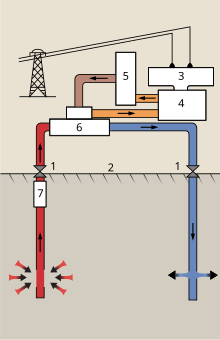Binary cycle

Key: 1 Wellheads 2 Ground surface 3 Generator 4 Turbine 5 Condenser 6 Heat exchanger 7 Pump
A binary cycle (also binary vapor cycle) in thermodynamics is a power generation method that uses two circuits, high temperature one and lower temperature one.[1] When used in a geothermal power plant, this allows for cooler geothermal reservoirs to be used than the 182 °C (360 °F) which is required for dry steam and flash steam plants.[2]
A binary cycle geothermal power plants first has two circuits; the first uses pumps to draw hot water from a geothermal well through a heat exchanger before returning it to the underground reservoir at a lower temperature. A second circuit uses a "working" or "binary" fluid with a low boiling point, typically a butane or pentane hydrocarbon, which is pumped at fairly high pressure (500 psi (3.4 MPa))[citation needed] through the heat exchanger, where it is vaporized and then directed at a higher pressure through a turbine. On exiting the turbine it then passes through cold air radiators or cold water which results in a substantial drop in pressure and temperature before it cycles back to the heat exchanger.[3]
Introduction to binary cycles[]
The use of mercury-water cycles in the United States can be dated back to the late 1920s. A small mercury-water plant which produced about 40 megawatts (MW) was in use in New Hampshire in the 1950s, with a higher thermal efficiency than most of the power plants in use during the 1950s. Unfortunately, binary vapor cycles have a high initial cost and so they are not as economically attractive.[4]
Water is the optimal working fluid to use in vapor cycles because it is the closest to an ideal working fluid that is currently available. The binary cycle is a process designed to overcome the imperfections of water as a working fluid. The cycle uses two fluids in an attempt to approach an ideal working fluid.[4]
Characteristics of optimal working fluids[]
Selecting the optimal working fluid has pivotal importance, since they make a significant impact on the performance of binary cycles.
- A high critical temperature and maximum pressure
- Low triple-point temperature
- A condenser pressure that is not too low (a substance with a saturation pressure at the ambient temperature is too low)
- A high enthalpy of vaporization (hfg)
- A saturation dome that resembles an inverted U
- High thermal conductivity (good heat transfer characteristics)
- Other properties: nontoxic, inert, inexpensive, and readily available
Systems[]
Rankine vapor cycle[]
The Rankine cycle is the ideal form of a vapor power cycle. The ideal conditions can be reached by superheating the steam in the boiler and condensing it completely in the condenser. The ideal Rankine cycle does not involve any internal irreversibilities and consists of four processes; isentropic compression in a pump, constant pressure heat addition in a boiler, isentropic expansion in a turbine, and constant pressure heat rejection in a condenser.[4]
Dual pressure[]
This process is designed to reduce the thermodynamic losses incurred in the brine heat exchangers of the basic cycle. The losses occur through the process of transferring heat across a large temperature difference between the high temperature brine and the lower temperature of the working fluid. Losses are reduced by maintaining a closer match between the brine cooling curve and the working fluid heating curve.[5]
Dual fluid[]
“Power is extracted from a stream of hot fluid, such as geothermal water, by passing the stream in heat exchange relationship with a working fluid to vaporize the latter, expanding the vapor through a turbine, and condensing the vapor in a conventional Rankine cycle. Additional power is obtained in a second Rankine cycle by employing a portion of the hot fluid after heat exchange with the working fluid to vaporize a second working fluid having a lower boiling point and higher vapor density than the first fluid.”[6]
Power plants[]
There are numerous binary cycle power stations in commercial production:
- Olkaria III, Kenya
- Mammoth Lakes, California, United States[7]
- Steamboat Springs (Nevada), United States[8]
- Te Huka Power Station, New Zealand [9]
Binary cycle power plants have a thermal efficiency of 10-13%.[10]
See also[]
- Geothermal electricity
- Working fluid
References[]
- ^ Çengel, Yunus A. & Michael A. Boles (2002). Thermodynamics: An Engineering Approach, Seventh Edition. Boston: McGraw-Hill. pp. Chapter 10.
- ^ "Geothermal Technologies Program: Hydrothermal Power Systems". Geothermal Technologies Program: Technologies. U.S. DOE Energy Efficiency and Renewable Energy (EERE). 2010-07-06. Retrieved 2010-11-02.
- ^ Scott, Willie (15 November 2010). "Geothermal Energy Power Plants and How They Produce Green Electricity". Bright Hub.
- ^ Jump up to: a b c d [Çengel, Yunus A., and Michael A. Boles. "Chapter 10: Vapor and Combined Power Cycles". Thermodynamics: An Engineering Approach. 7th ed. Boston: McGraw-Hill, 2002. 557-89. Print.], additional text.
- ^ Ronald DiPippo (2008). Geothermal Power Plants: Principles, Applications, Case Studies and Environmental Impact. Amsterdam: Butterworth-Heinemann.
- ^ "DUAL FLUID CYCLE". United States, Patent No.3795103. 1974.
- ^ "Mammoth Pacific Geothermal Power Plant Honored with Environmental Award from State of California". Ormat. 20 August 2009.
- ^ "Steamboat Springs".
- ^ "Te Huka Geothermal Power Plant". Global Energy Observatory.
- ^ Ronald DiPippo (2007). Geothermal Power Plants, Second Edition: Principles, Applications, Case Studies and Environmental Impact. Oxford: Butterworth-Heinemann. p. 159. ISBN 0-7506-8620-0.
External links[]
- Geothermal energy

